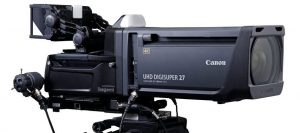NAB Reflections: Ikegami Offers a 4K First, Continues Push to 8K
New UHK-435 4K studio camera targets news shows, esports
Story Highlights
Ikegami sees its UHK-435 camera as the big game-changer this year: it’s the first 2/3-in. three–CMOS-sensor 4K/HD studio camera.
“We aren’t doing single-chip and trying to adapt,” says Erin Rice, sales manager, sports and entertainment, Ikegami, adding that it is the perfect solution for studio news shows or esports programs. “Esports is growing by leaps and bounds, and we are looking at it as a real growth market.”
As the studio companion version of the UHK-430 4K camera from Ikegami’s Unicam XE series, the UHK-435 captures the extended depth of focus of the 2/3-in. format and permits use of the full range of B4 studio and field box lenses.
The UHK-435 delivers wide dynamic range and wide color gamut and fully supports HLG (hybrid log-gamma), conforming to HDR International Standard ITU-R BT.2100.
“[High dynamic rate] is huge this year,” notes Rice, referring to one of the top trends at NAB 2018.
Ikegami also is focused on a growing market segment, especially in the U.S. market: 1080p HD cameras that support HDR needs. The HDK-99 is the successor to Ikegami’s HDK-95C, and it has 2.6-megapixel high-performance CMOS image sensors and a wide dynamic range of more than 600%.
HLG mode is featured on the HDK-99, allowing the range represented to expand from dark to bright, thus providing superb bright pictures with HDR while achieving rich colors with wide color gamut.
In addition, the Lens Aberration Correction function on the Ikegami HDK-99 minimizes loss of resolution and colored edges caused mainly by lens chromatic aberration. The Quick EZ Focus Assist Function provides very distinct enhancement to the viewfinder signal, enabling the camera operator to make critical focus adjustments. Area size, area color, edge color, and display time on the viewfinder are all adjustable in the camera menu.
Ikegami continues to help extend the possibilities of 8K production, rolling out the SHK-810 8K UHDTV camera. Developed with Japan Broadcast Corp. (NHK), the SHK-810 is a breakthrough camera notable for the significant size reduction and lightweight design that it brings to field and live production, operating with the same ease as current broadcast cameras.
“It’s a fourth-generation 8K cameras; we started on 8K six years ago with NHK,” says Rice. “We will be at our fifth generation before too much longer.
One application for more-traditional broadcast needs is using the 8K camera to capture a single image of the field of play and then use a replay server to extract a region of interest at HD resolution. Ikegami has done tests with MLB on just such an application.
“You can use Evertz or EVS to do replays at a much higher resolution than 4K,” Rice notes, “and it can be used for challenge replays or just to provide extra resolution so the fans see something they haven’t seen before.
The SHK-810 deploys a 33 million-pixel Super 35mm CMOS sensor with PL lens mount, achieving a limiting horizontal resolution of 4,000 TV lines. This portable camera uses standard SMPTE hybrid camera cable between head and CCU with available portable and studio viewfinders. Pictures from the SHK-810 can be viewed on a prototype Ikegami-designed 55-in. full 8K-resolution LCD monitor.
One interesting feature of the UHK-430 4K camera is its interchangeable optical block built on 40 Gbps, enough bandwidth to support 8K.
Notes Rice, “You can put an 8K optical block in the camera and go 8K in the future and have a camera that has a smaller footprint [than other 8K options] and is also cheaper.”

